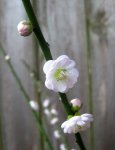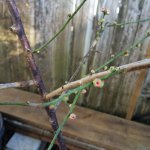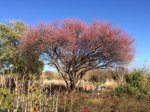fredtruck
Omono
Whenever I have a tree idea, I like to try out the idea using material that can usually be described as “stick-in-a-pot.” The reason I do it this way is that material like this is cheap, and can be worked into most shapes fairly easily. If the idea works out, then I look for more heavy duty tree material. Rarely, a project like this turns into something more.
Most of us have come across the following statement or one of its variants: it’s a deciduous tree styled like a conifer.
I wondered what that really meant. I’ve seen many trees that look like a letter “l” with a triangle on top, but that wasn’t interesting enough. One of my favorite Japanese literati trees has a relatively straight trunk with many falling branches. I decided to go that route.
I bought a prunus mume omoi no mama from Camellia Gardens, put it in the ground for a growing season, brought it inside for the winter, and then put it in the ground for another spring, summer and fall. While it was still in the ground, I bent it into a shepherd’s crook that slanted backwards and began bending the various branches as they appeared with the idea of styling it like a conifer.
At the end of the second growing season, I potted it up and brought it inside. I kept bending the loop in the shepherd’s crook until it finally cracked, giving me the sharp bend I was after. I’ve had many problems with dieback on this tree. Branches seem to come and go, so it may not look this way next year.
As all this was going on, the tree flowered. Prunus mume omoi no mama is famous for its multi-colored flowers. With this tree, I haven’t found that. Instead, I have mostly white flowers that are tinged with a number of tints that are difficult to describe. (See picture below.) The big advantage is the flowers are very small.
Meanwhile, I finally found the front of the tree. It’s a dead straight-on view. In the flower enlargement, the shepherd’s crook is easy to see.


Most of us have come across the following statement or one of its variants: it’s a deciduous tree styled like a conifer.
I wondered what that really meant. I’ve seen many trees that look like a letter “l” with a triangle on top, but that wasn’t interesting enough. One of my favorite Japanese literati trees has a relatively straight trunk with many falling branches. I decided to go that route.
I bought a prunus mume omoi no mama from Camellia Gardens, put it in the ground for a growing season, brought it inside for the winter, and then put it in the ground for another spring, summer and fall. While it was still in the ground, I bent it into a shepherd’s crook that slanted backwards and began bending the various branches as they appeared with the idea of styling it like a conifer.
At the end of the second growing season, I potted it up and brought it inside. I kept bending the loop in the shepherd’s crook until it finally cracked, giving me the sharp bend I was after. I’ve had many problems with dieback on this tree. Branches seem to come and go, so it may not look this way next year.
As all this was going on, the tree flowered. Prunus mume omoi no mama is famous for its multi-colored flowers. With this tree, I haven’t found that. Instead, I have mostly white flowers that are tinged with a number of tints that are difficult to describe. (See picture below.) The big advantage is the flowers are very small.
Meanwhile, I finally found the front of the tree. It’s a dead straight-on view. In the flower enlargement, the shepherd’s crook is easy to see.













